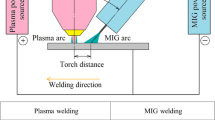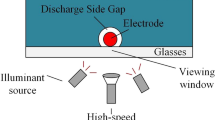Abstract
An automatic voltage control technique, to optimise gas metal arc welding (GMAW) conditions for minimised fume generation, was compared to conventional constant-voltage operation on the influence of shielding gas on fume formation rate (FFR) and particle size distribution. Significant reductions in FFR were attributed to reductions in the arc length and current and to improved metal transfer stability, achieved by promoting the ‘drop-spray’ transfer condition and reducing repelled globular transfer. A general decrease in average particle size was observed when using the automatic control technique for the O2-bearing shielding gases, which is significant, as finer particulates are more likely to be inhaled into the lungs. The proposed mechanism to explain this behaviour was lower arc temperatures combined with an increase in the availability of oxygen, leading to nucleation of large amounts of extremely fine fume particles when the supercooling of the vapour was large. FFR increased as CO2 content increased due mainly to the dominant influence of CO2 on metal transfer and arc characteristics. It is recommended that the influence of shielding gas on FFR should be investigated using optimised welding conditions for each shielding gas composition for GMAW, especially when operating in the spray regime.









Similar content being viewed by others
References
Hewitt PJ, Hirst AA (1991) Development and validation of a model to predict the metallic composition of flux cored arc welding fumes. Ann Occup Hyg 35(2):223
Voitkevich V (1995) Welding fumes: formation, properties and biological effects. Special report. Abington Publishing, Cambridge, England
Deam RT, Simpson SW, Haidar J (2000) Semi-empirical model of the fume formation from gas metal arc welding. J Phys D Appl Phys 33(11):1393
Ioffe I et al (1995) Fume formation rate at globular to spray mode transition during welding. J Phys D Appl Phys 28(12):2473
Heile RF, Hill DC (1975) Particulate fume generation in arc welding processes. Weld J 54(7):201–210
Jin Y (1994) Fume generation form gas metal arc welding processes. Staub - Reinhaltung der Luft 54(2):67
Sterjovski Z et al (2006) An investigation of particulate weld fume generated from the GMAW of plain carbon steel. Australiasian welding journal 51(1–4):34–40
Carpenter KR, Monaghan BJ, Norrish J (2009) Analysis of fume formation rate and fume particle composition for gas metal arc welding (GMAW) of plain carbon steel using different shielding gas compositions. ISIJ Int 49(3):416–420
Gray CN, Hewitt PJ, Hicks R (1980) Effect of oxygen on the rate of fume formation in metal inert gas welding arcs. Proceedings - Biennial Cornell Electrical Engineering Conference 1:167
Pires I et al (2006) Fume emissions during gas metal arc welding. Toxicol Environ Chem 88(3):385
Smith AA (1978) Classification of shielding gases used in the gas-shielding arc welding of ferrous metals—on the basis of their oxidation potential. Welding in the World 16(1/2):25–30
Stenbacka N, Person K-A (1989) Shielding gases for gas metal arc welding. Weld J 68(11):41–47
Castner HR (1995) Gas metal arc welding fume generation using pulsed current. Weld J 74(2):59–68
Jenkins, N.T., P.F. Mendez, and T.W. Eagar (2005) Effect of arc welding electrode temperature on vapor and fume composition. in Proceedings of the International Conference: Trends in Welding Research. Pine Mountain, GA, United States: ASM International, 9639 Kinsman Road, OH 44073–0002, United States
Richardson, I., J. Norrish, and M. Hermans, The mechanism and significance of drop spray transfer in GMAW, in IIW Doc. No. XII-1893-06. 2006
Pires I et al (2010) Reduction of fume and gas emissions using innovative gas metal arc welding variants. Int J Adv Manuf Technol 50(5–8):557–567
AS 2985:2005, Workplace atmosphere—method for sampling and gravimaetric determination of respirable dust. Standards Australia, 2004
Jenkins NT, Eagar TW (2003) Submicron particle chemistry: vapor condensation analogous to liquid solidification. JOM-Journal of the Minerals Metals & Materials Society 55:44–47
Jenkins NT, Pierce WM-G, Eagar TW (2005) Particle size distribution of gas metal and flux cored arc welding fumes. Weld J 84(10):156s–163s
Friedlander SK (1977) Smoke, dust and haze: fundamentals of aerosol behavior. John Wiley & Sons, New York
Sterjovski Z, Norrish J, Monaghan BJ (2010) The effect of voltage and metal transfer mode on particulate fume size during the GMAW of plain carbon steel. Welding in the World 54(9):R249–R256
Cuiuri, D., A. Nicholson, and J. Norrish (2000) WO/2008/151393: apparatus and method for monitoring welding, WIPO, Editor. 2008, SHELSTON IP; 60 Margaret Street, Sydney, NSW (AU): Australia
Norrish J (1992) In: Wood J, Apelian D (eds) Advanced welding processes. New manufacturing processes and materials series. Institute of Physics Publishing, Bristol
Pires I, Quintino L, Miranda RM (2007) Analysis of the influence of shielding gas mixtures on the gas metal arc welding metal transfer modes and fume formation rate. Mater Des 28(5):1623
Lesnewich, A. (1958) Control of melting rate and metal transfer in gas-shielded metal-arc welding. Welding J:343 s–353 s
Middleton P, Olivera Santos JF, Quintino L (1992) Synergic algorithms to relate wire feed rate to arcing current for conventional GMA welding. Joining Sciences 1(2):87–93
Hu J, Tsai HL (2007) Heat and mass transfer in gas metal arc welding. Part II: the metal. Int J Heat Mass Transf 50(5–6):808–820
Mendez, P.F., N.T. Jenkins, and T.W. Eagar (2000) Effect of electrode droplet size on evaporation and fume generation in GMAW. in Proceedings of the gas metal arc welding for the twenty-first century conference. Orlando, FL.
O’Brien, R.L. and L.P. Connor (1991) Welding handbook. 8 ed. Welding Processes, ed. R.L. O’Brien. Vol. 2. Miami: AWS. 133–136
Acknowledgements
Linde-BOC Gases, Australia, are gratefully acknowledged for the funding and support for this project.
Author information
Authors and Affiliations
Corresponding author
Additional information
Recommended for publication by Commission VIII - Health, Safety, and Environment
Electronic supplementary material
ESM 1
(DOCX 9816 kb)
Online resource 1
Ar-5CO2-32 V video; long arc length with fluctuations in arc width. Droplets collided with one another and a few exploded due to arc interactions between colliding droplets. This appeared to generate increased fume. Larger droplets rotated within the arc. (AVI 3355 kb)
Online resource 2
Ar-5CO2-Auto video; Shorter arc length and more stable compared to 32 V, but also had several exploding droplets that destabilised the arc (AVI 3584 kb)
Online resource 3
Ar-10CO2-32 V video; longer arc length and fluctuation in the arc width due to periodically larger droplets. Typically streaming spray transfer, at an increased rate compared to auto-control. There were multiple droplet collisions and rotating droplets in the arc. (AVI 3442 kb)
Online resource 4
Ar-10CO2-Auto video; Shorter arc length, mixture of drop-spray transfer and streaming spray transfer. Arc more stable than 32 V, but still had fluctuations in the arc width. There was less droplet interaction during drop-spray transfer compared to streaming spray. (AVI 3832 kb)
Online resource 5
Ar-18CO2-32 V video; long arc length with fluctuations in width. Typically streaming spray transfer where the conglomeration of droplets was common. There were some exploding droplets due to arc interactions between droplets.) (AVI 3661 kb)
Online resource 6
Ar-18CO2-Auto video; typically showed repelled globular transfer and had a very short arc length. (AVI 3876 kb)
Online resource 7
Ar-18CO2-32 V-Glob video; Repelled globular transfer was observed (short arc lengths) when using Ar-18CO2 (AVI 3784 kb)
Online resource 8
Ar-5CO2-2O2-32 V video; Very long arc length and fluctuations of arc width. Typically streaming spray transfer, where the conglomeration of droplets was common. There were several exploding droplets due to arc interactions between droplets (AVI 3524 kb)
Online resource 9
Ar-5CO2-2O2-Auto video; Significantly shorter arc length compared to 32 V. Mixture of streaming spray and drop-spray transfer, with very few exploding droplet events (AVI 3531 kb)
Online resource 10
Ar-5CO2-5O2-32 V video; long arc length with fluctuations in width. Typically streaming spray transfer where the conglomeration of droplets was common. Some large conglomerations were partially repelled by the arc below the droplet. There were only a few cases of exploding droplets due to arc interactions between droplets. (AVI 3617 kb)
Online resource 11
Ar-5CO2-5O2-Auto video; Much shorter arc length and arc transfer was a mixture of streaming spray and drop-spray and the arc was much more stable compared to 32 V. (AVI 3621 kb)
Online resource 12
Ar-12CO2-2O2-32 V video; Short arc length. Arc transfer was a mixture of streaming spray with repelled globular, where multiple droplet explosions occurred. Substantial arc interactions were visible with larger droplets, which appeared to generate increased fume. (AVI 3964 kb)
Online resource 13
Ar-12CO2-2O2-Auto video; short arc length. Arc transfer was predominately repelled globular. Arc was relatively unstable compared to other Auto-control tests. (AVI 3489 kb)
Online resource 14
Ar-18CO2-2O2-32 V video; Long arc length with streaming spray transfer. Substantial arc interactions were visible with larger conglomerated droplets, which appeared to generate increased fume. There were several instances of repelled globular transfer with short arc lengths and high fume generation (AVI 4431 kb)
Online resource 15
Ar-18CO2-2O2-Auto video; Typically a shorter arc length compared to 32 V. Arc transfer was streaming spray with significant interactions with the arc, where multiple droplets exploded, generating increased fume (similar to repelled globular transfer). The arc was relatively unstable. (AVI 3517 kb)
Online resource 16
Ar-20He-12CO2-32 V video; Mixture of spray transfer and repelled globular, where a long detachment event was observed at the end of the video. The brightness of the arc beneath the forming droplet, indicating a very hot arc, would generate increased fume. Larger droplets tend to rotate and cause arc instability. (AVI 3798 kb)
Online resource 17
Ar-20He-12CO2-Auto video; Mixture of spray and repelled globular transfer, but with a much shorter arc length compared to 32 V. Larger droplets tend to rotate and cause arc instability. (AVI 4116 kb)
Online resource 18
Ar-30He-6CO2-32 V video; Streaming spray transfer and a long arc length. Conglomeration of droplets was frequent and larger droplets tended to rotate (AVI 3924 kb)
Online resource 19
Ar-30He-6CO2-Auto video; Predominately repelled globular transfer with some arc instabilities. Very short arc length. There was a period of drop-spray transfer towards the end of the video. (AVI 4393 kb)
Online resource 20
Ar-30He-10CO2-32 V video; Moderate arc length. Mixture of spray transfer and repelled globular. Arc instabilities occurred during large droplet formation and detachment, which would be expected to increase fume generation. (AVI 3950 kb)
Online resource 21
Ar-30He-10CO2-Auto video; Moderate arc length, similar to 32 V. Predominately streaming stray transfer, where there was significant narrowing of the end of the electrode. Arc interactions between streaming droplets is clearly visible. Arc more stable compared to the 32 V tests. (AVI 3555 kb)
Rights and permissions
About this article
Cite this article
Carpenter, K.R., Monaghan, B.J., Cuiuri, D. et al. Optimising the welding conditions to determine the influence of shielding gas on fume formation rate and particle size distribution for gas metal arc welding. Weld World 61, 473–481 (2017). https://doi.org/10.1007/s40194-017-0438-9
Received:
Accepted:
Published:
Issue Date:
DOI: https://doi.org/10.1007/s40194-017-0438-9




